

ELEVENTH SPAWN: An account of how my eleventh betta spawn went
(Click on Bettas to return to the main betta page or on main site to browse 70 topics ranging from exotic kaleidoscope designs to the strange world of lucid dreaming.)

The dance begins!
(In
real life Ariel's fins are pure, intense red.
There
is no hint of orange as shown in this photo.)
This spawn is a case up uptown girl meeting a downtown guy. Ariel is a high-bred Apache double tail from Faith at BettaTalk. Carl is is a lowly Wal-Mart betta. Let's hope they can overcome class distinctions and have a successful spawn.
They had been jarred next to each other and actively courting for a month so at 8:30 AM on 19 January, 2003, they were released into the spawning tank without isolating them for a few days. I thought they'd be ready to go. They were... but I forgot that Carl hadn't had time to build a bubble nest. It'll be interesting to see how they work things out. As of 2:00 PM of the same day she was alternately running away and seeking him out, which is normal behavior.
My goal for this spawn is to get some fish with pearly-white bodies and pure red fins.
After several hours, it was obvious that Carl was so busy courting that he wasn't going to make a bubble nest. I collected nests from other fish and placed them under the half-butter tub I use for a nest anchor. He immediately got the hint and started adding to it. By evening the nest was large enough to make any betta proud.
Ariel had locked herself away in the plants and showed no interest in spawning so I turned the lights out and let them have a night's sleep to rest up. As soon as I turned on the lights the next morning, she scurried out of her hideaway and took up position under the bubble nest. By 9:30 they'd started spawning and the first eggs began appearing. So, the first birthday for this spawn is 20 March, 2003.
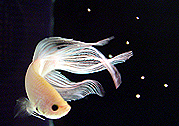
Carl twists and turns to catch the eggs.
Although this is the first spawn for both fish, they didn't exhibit any awkwardness. Every embrace produced 10 to 20 eggs. Carl was quick to catch them and blow them into the nest. From the rate at which they are producing eggs, this could be a very large spawn.
The spawn ended suddenly at 12:30 PM. Ariel and Carl enjoyed one final embrace and she immediately swam away to hide. Now comes the hard part: waiting two days to see if any of the eggs hatch.
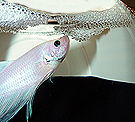
Carl
guarding his bubble nest. The sagging bulge of
bubbles
in front of his nose is a solid mass of eggs.
March 21: THERE ARE FRY! One, anyway. I checked the bottom of the spawning tank at 8:30 PM Friday night and was surprised to see a fry laying on the bottom. He was still mostly egg with just a hint of eyes and a short wisp of tail.
![]()
Could
this be the white-bodied, red-finned fish I'm hoping for?
Time
will tell. (Shown ten times actual size.)
It usually take 48 hours for the first fry to show up. This guy's twelve hours early.
March 22, 7 AM: When I checked the bubblenest early Saturday morning, I panicked at first because I couldn't see any eggs in it or tails hanging down. Having dealt with egg eating males in the past, I feared the worst. Then I looked at the top of the nest and spotted dozens of little black eyes staring back at me.

A
small section of the bubblenest, much enlarged, showing 34 pairs of eyes.
March 22, 11 AM: Four hours later all the fry have hatched and were dashing every which way. Carl wasn't able to keep up with them so I took him out. Here's what the fry look like 48 hours after being laid:
![]()
Comparing this to the premature fry above shows that much more of the yoke sack has been absorbed.

Some of the fry on the bottom of the tank.
The picture above is a small section of the bottom of the spawning tank. By taking a larger picture and counting all the fry I could see I discovered Ariel and Carl had produced 613 fry. This is outstanding for a pair's first spawn.
So far this spawn is going even better than Tangerine's and Mango's spawn. I hope to have another update in a few weeks so please check back from time to time.
NEW UPDATE!!!
March 30: The fry are one week old and doing excellently. So far only six have died. This is outstanding for this large a spawn. I fed them vinegar eels for the first two days then switched to baby brine shrimp. The frys' growth is phenomenal. On the third day after hatching they could barely manage to eat two brine shrimp each. By the fifth day after hatching they were averaging 14 brine shrimp.

A picture of a one week old fry, much enlarged. The yellow area is a stomach full of baby brine shrimp. When fed vinegar eels, the stomach is silvery white.
April 2: I spotted three fry with red marks on their foreheads. I diagnosed this as a bacterial infection and treated it with Kanacyn. Twenty-four hours later I couldn't find a single fry with red marks. This stuff is great!
April 4: At 1 and 1/2 weeks old, the average fry will eat 40 baby brine shrimp before it's so full it won't eat even if a brine shrimp bumps into the its nose. Seven hours later, the fry's stomach is empty. Taking this as an indication that the fry can be fed more often than just morning and evening, I started feeding them three times a day. They appear to have responded to this by growing faster.
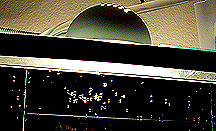
Although
I keep the tank at 77 degrees, there are always a
couple
of dozen fry basking in the light from the overhead lamp.
April 6: I've noticed that 1/4 to 1/3 of the fry have a notch in the upper half of their tails. At first I thought this might be a case of fin rot, but then I remember that Ariel, the mother, was a double tail. I assume the notch indicates she passed this trait along. I hope that the lobes even up as the fry grow. Right now the bottom lobe appears to be four times the size of the upper.

The
actual fry is only 1/4 inch long.
April 13: Either the bacterial infection I reported earlier has returned or a new one has started up. Ten fry have died in the last three days and the Kanacyn, which worked so well in the past, doesn't seem to be helping. I'm going to scrub the tank this morning, do a 95-percent water change and hit the tank with a heavy dose of tetracycline. Wish me luck.
In spite of the infection, the fry have continued to increase their rate of brine shrimp consumption. They are now up to consuming the shrimp hatched from 1/3 of a teaspoon every day. Even allowing for the fact that there are still well over 500 fry in the tank, that's a lot of food. They continue to grow very fast. It appears that stepping up the feeding schedule to three times a day is paying off.
April 16: I gave the fry their first taste of Grindal worms. Some of the worms were as long as the fry, but that didn't stop the fry from gobbling them down... once they figured out that the worms were food.
April 20: I took a photo of the fry and used it to count how many are left after the second bacterial infection: only 158. That means I lost 450 fry. That's hard to believe, but numbers don't lie. Anyway, no fry have died in four days and there are no red spots on any of them so I guess the tetracycline beat the infection. Again, I got the impression it didn't cure the sick fish as much as it only kept the healthy fish from catching it.
Things should get exciting soon. In only two weeks some of the fry could begin showing color. Will any of them be the pearly-white bodied, red finned fish I'm hoping for?
April 26: None of the fish (they've started breathing air so I no longer consider them fry) are as yet showing color. This is disappointing since the tenth spawn fry started showing at three and a half weeks. The 157 remaining fry, I lost one during a siphoning, are eating all the brine shrimp I can hatch for 2/3 of a teaspoon of cysts. The tank is almost opaque with shrimp when I feed them, yet twenty minutes later it's clear and all the fry have bulging stomachs.
April 27: First Color! Three fish are showing a faint blue-white wash on their fins and one has a tinge of red in it's tail.
May 4: Half a dozen fish now have the white wash and three show red. The following is the best:
![]()
Taking pictures of the fish has become an exercise in patience because they have learned to associate my being close to the tank with being fed. The result is that they swarm in front of the camera making it difficult to get a clear shot of a single fish.
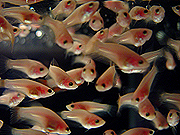
May 6: I spotted a fish flaring for the first time today! At only six weeks old, this is earlier than usual for my spawns. However, this spawn has grown faster than any of the others and the fish are more crowded than typical, which can increase aggressive behavior. I need to thin them out.
May 14: Half of the fish are showing the pearly-white coloring in their bodies and red in fins that I was hoping for. Forty percent look like the mother: flesh colored bodies and red fins. The remaining ten percent are light like their father.
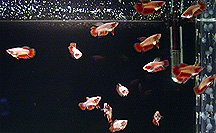
May 17: The fish have continued growing very fast. Here are what their two main color patterns look like:
![]()

The white-bodied type on the left is more what I was hoping for. (Their tails aren't much wider when they are in full display.)

Half show a hint of the double tail their mother had. Unfortunately, none of these has equally sized lobes, the top lobe is always smaller than the bottom.

One, who is the largest and has become my favorite, is very unusual because he inherited the extra tail width of his double tail mother but not the double lobes. His tail is almost a full moon tail as seen in top quality delta tails. Comparing this photo the the tails in the first two fish in this update clearly shows the difference. It will be interesting to see what he looks like in five months when he has finished growing his veil tail.

Two weeks later his body turned orange.

This is the best white-bodied, red-finned fish.
Final update: After another month it was clear that none of the fish were going to develop the pearly-white bodies and solid red fins I'd hoped for. I kept the two best and gave the remainder to friends and a local pet store.